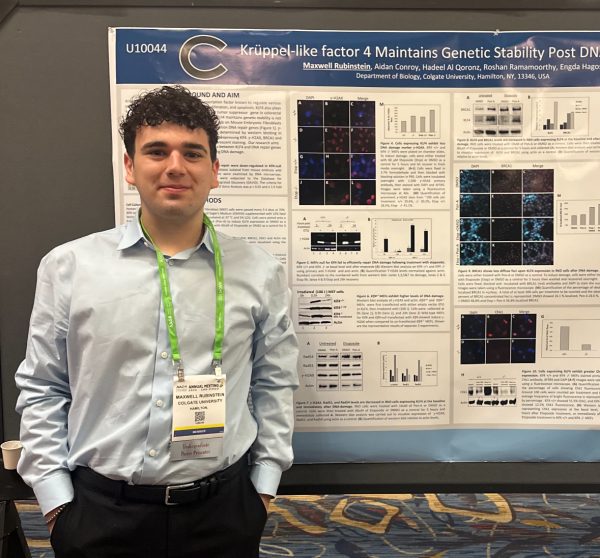Professor Sorwell: The Science Behind Love and Attraction
The science of love and attraction has been an area of research pertaining to human behavior for decades. There are so many questions to be asked and understood about why individuals are attracted to certain people, why humans are motivated to form socially monogamous relationships and what the neural mechanisms are behind those behaviors. Studies utilizing monkeys, birds, prairie voles and humans, among others, have been able to uncover some answers to these questions. Dr. Krystina Sorwell, a visiting assistant professor of psychological and brain sciences at Colgate University, has explored the science behind attraction as a student and professor in the context of the endocrine system, brain and human behavior.
Originally from Chicago, Sorwell moved around the country while pursuing her education, receiving her Bachelor’s Degree in Neuroscience from Boston University and her PhD in Behavioral Neuroscience from Oregon Health and Science University (OHSU). She also completed post-doctoral training in research at OHSU and training in teaching at Linfield University.
“Early on, I studied how hormonal changes influence the ability of mice to make decisions about social odors, which really cemented my interest in the relationship between hormones and behavior. […] Right now, I’m working on a project to see if environmental cues can alter the stress axis to engage different problem-solving strategies in birds, as well as a series of studies in humans looking into the effect that context, including social perspective, stress, language and environment, can have on our ability to be creative,” Sorwell said.
Her general area of study is cognitive endocrinology, which deals with the collaboration of the brain and hormones in influencing thought. In her graduate studies, Sorwell explored the complex relationships between endocrine systems and the brain in monkeys while looking at potential hormonal therapies and their preventative effects on age-influenced cognitive decline. Since then, she has explored the science behind attraction, which includes every aspect of human behavior, on her own and as a topic she teaches to students.
“Biologically speaking, our bodies and brains evolved to create more of ourselves, so becoming attracted and attractive to another is priority one […] Familiarity is a major component to attraction. If we see the same stimulus over and over, our brain starts to think ‘Hey, this is something I should pay attention to.’ So if we see the same person over and over, we’re more likely to consider them as a romantic partner,” Sorwell said.
According to Sorwell, however, there is still a biological drive to pursue variation as a way to mix genetics. A person is more likely to pursue another individual that is further away from themself, genetically speaking. Attraction becomes much more complicated the further you look into the mechanisms that drive our behavioral decisions, even becoming predictably variable throughout hormonal cycles in a reproductive context.
“Love is another story. We understand biological mechanisms of love from work looking at monogamous animals,” Sorwell explained.
As it turns out, many animals that were thought to be monogamous are socially monogamous, meaning they form a close bond with one partner, but are not sexually monogamous.
“That’s actually very similar to how humans approach their relationships: we often choose short-term relationships, especially during our prime reproductive years, but we still value close partnerships […] It’s likely that culture, and humans’ need to create close-knit, trusting social groups, informs the modern view of monogamy, rather than biology alone,” Sorwell said.
Humans and other socially monogamous animals rely on the hormone oxytocin to promote bonding in social groups, with a partner, or even with a dog and their owner.
“The experience of love does seem to involve very distinct patterns in the brain. First of all, there is a […] connection to brain circuits involved in addiction. Addiction is an increased motivation to pursue some experience beyond what is expected or typical to a debilitating degree, and anyone who’s ever been in love can probably relate to that,” Sorwell said.
“We know a lot about cis-heterosexual sexuality and relationships, and a good amount about cis-homosexual male relationships, but bisexuality, pansexuality, cis-homosexual female relationships, polyamorous and transgender relationships are still to be explored from the biological perspective,” explained Sorwell.
She is hopeful that with more encouragement from the growing field of science and understanding of sexuality more attention will be directed to this area of study.
Over the past three years as a visiting professor, Sorwell has enjoyed teaching Biological Psychology, Research Methods in Psychological Science, Cognitive Neuroscience and Behavioral Endocrinology at Colgate. She has been impressed with the level of dedication and curiosity expressed by the students in her classes.
“Hard questions never get easy, but I’ve seen students at Colgate become motivated by the tough stuff instead of shying away. That makes the classroom experience so much more engaging and fruitful.”
Outside of her extensive interests in neuroscience, Sorwell enjoys a variety of hobbies. When the weather is nice, she can be found spending time outside hiking, camping, gardening and exploring. On days when the weather is not so good, Sorwell enjoys making music, cooking, baking, doing crafts and spending time with her three cats and dog.












